Topic: Key To Weather Map Symbols
Key To Weather Map Symbols
Which type of air mass would most likely form over the Pacific Ocean north of the Aleutian Trench?
(1) mP
(2) mT
(3) cP
(4) cT
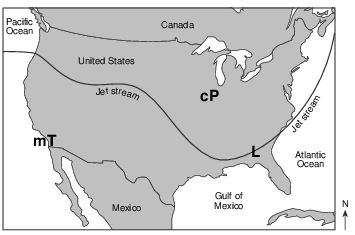
What is the difference in the air temperature and humidity between the cP and mT air masses?
(1) The cP air mass is warmer and less humid.
(2) The cP air mass is colder and more humid.
(3) The mT air mass is warmer and more humid.
(4) The mT air mass is colder and less humid.
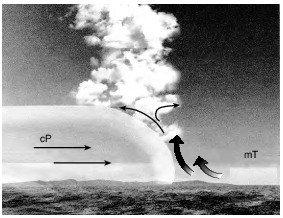
Which statement best describes the difference in air temperature and humidity between the cP and mT air masses?
(1) The mT air mass is warmer and more humid.
(2) The mT air mass is cooler and less humid.
(3) The cP air mass is warmer and less humid.
(4) The cP air mass is cooler and more humid.
Which type of air mass most likely has high humidity and high temperature?
(1) cP
(2) cT
(3) mT
(4) mP
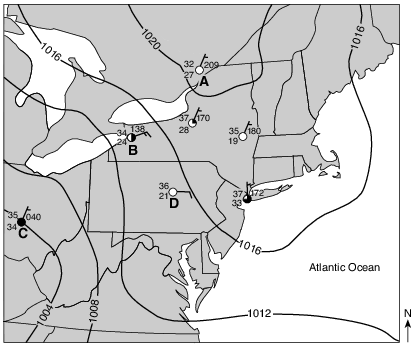
Which weather station had the highest relative humidity?
(1) A
(2) B
(3) C
(4) D
When it is solar noon at a location at 75° W longitude, what is the solar time at a location at 120° W longitude?
(1) 9 a.m.
(2) 12 noon
(3) 3 p.m.
(4) 12 midnight

Which map best represents the type of fronts and direction of movement of these fronts in relation to the low-pressure center?
(1) 
(2) 
(3) 
(4) 
The map of North America below shows the source region of an air mass forming mostly over Mexico.

This air mass originating over Mexico is classified as
(1) continental polar
(2) continental tropical
(3) maritime polar
(4) maritime tropical
The station model below shows some weather conditions at a location on Earth’s surface.

Which present weather symbol represents the most likely type of precipitation occurring at this location?

(1) 1
(2) 2
(3) 3
(4) 4
Which rock will weather at the fastest rate when exposed to acid rain?
(1) granite
(2) limestone
(3) gneiss
(4) quartzite
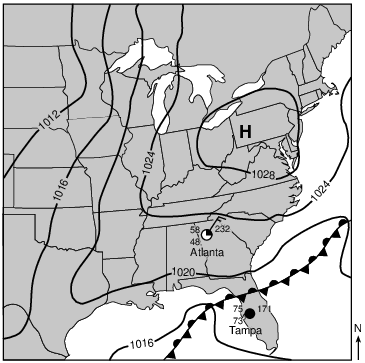
Describe one piece of evidence shown on the map that indicates that Tampa, Florida, has a high probability of precipitation. [1]
Allow 1 credit. Acceptable responses include, but are not limited to:
• — The dewpoint and air temperature are close together./high relative humidity
• — 100% cloud cover/overcast
• — Tampa is close to a front.
• — The air pressure is low.

An air mass acquires the characteristics of the surface over which it forms. In image below, circle the type of Earth surface (land or ocean) and describe the relative temperature of the surface over which the mT air mass most likely formed. [1]
Circle one: land ocean Relative temperature of Earth’s surface:
Allow 1 credit for circling ocean and correctly describing the relative temperature of Earth’s surface. Acceptable descriptions include, but are not limited to:
• — warmer
• — hot
• — a tropical temperature
• Note: Do not allow credit for a numerical answer because there are no temperatures indicated for
• comparison.

Use the standard two-letter air-mass symbols to identify air-masses X and Y. [1]
Air-mass X:
Air-mass Y:
Allow 1 credit for a correct response for both air-mass symbols. Allow credit even if all uppercase letters are used.
• — Air-mass X: cP or cA
• — Air-mass Y: mT
• Note: Do not allow credit if the letters are reversed, such as Pc.
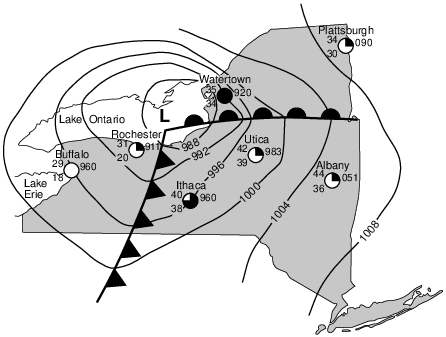
State the compass direction toward which the center of this low-pressure system moved over the next two days if the low followed a normal storm track. [1]
Allow 1 credit. Acceptable responses include, but are not limited to:
• — East/E
• — East northeast/ENE
• — Northeast/NE
• — North northeast/NNE

On the station model in the image provided, using the proper format, record the barometric pressure of the low-pressure center (L) on March 16. [1]

Allow 1 credit for 985 placed in its proper location.
• Example of a 1-credit response:
• 
•
• Note: If other weather variables are included on the station model, only the barometric pressure
• is to be scored.
